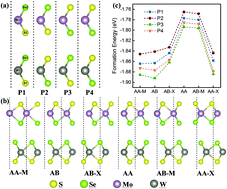The strain effect on the electronic properties of the MoSSe/WSSe van der Waals heterostructure: a first-principles study
Abstract
The structural, mechanical and electronic properties of the MoSSe/WSSe van der Waals (vdW) heterostructure under various degrees of horizontal and vertical strain are systematically investigated based on first-principles methods. It is found that the MoSSe/WSSe vdW heterostructure of the most stable AB stacking is a direct band gap semiconductor and exhibits a type-II band alignment, which demonstrates an effective separation of photogenerated electron–hole pairs and increases their lifetime accordingly. The high angle-dependent Young's modulus and normal Poisson's ratios show the mechanical stability and anisotropy. It is found that the band gap of the heterostructure can be modulated effectively by applying strain, exhibiting a decreasing trend with increasing strain, and even lead to an intriguing semiconductor–metal transition under a certain large tensile strain. In particular, a negative correlation between the band gap and structure pressure provides a theoretical basis for experimentally regulating the electronic properties. Moreover, different strains can induce two different conditions of direct–indirect transition or can maintain the characteristics of the direct-band-gap. All these interesting results provide a detailed understanding of the MoSSe/WSSe vdW heterostructure under strain and indicate that it is a good candidate for low-dimensional electronic, nano-electronic and optoelectronic devices.

- This article is part of the themed collection: 2020 PCCP HOT Articles


 Please wait while we load your content...
Please wait while we load your content...